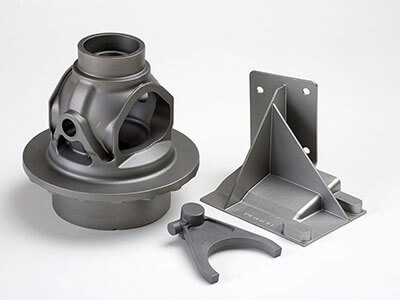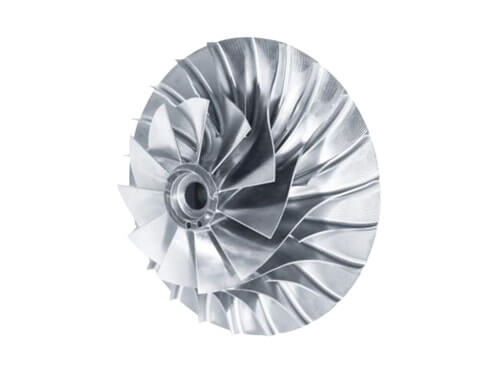Simple Guide to Metal Casting
- The metal casting process has over a 7,000-year history and is used in manufacturing. It is defined as the process in which molten metal is poured into a mold that contains a hollow cavity of the desired shape.
- Metal casting can be divided into two groups by the basic nature of the mold design. i.e. expendable mold and permanent mold castings. It can be further subdivided into groups depending on their pattern material.
- Highly engineered castings are found in 90 percent of durable goods, including cars, trucks, aerospace, trains, mining and construction equipment, oil wells, appliances, pipes, hydrants, wind turbines, nuclear plants, medical devices, defense products, toys, and more.
Gray iron is one of the most frequently used casting materials in industrial manufacturing. Accounting for a large portion of casting supply markets, it is a strong, versatile substance. Gray iron can be machined easily, tested for quality without using destructive methods, formulated to meet specific application requirements, and cost-effective at high volumes.
Cast steel is a tough casting material well-suited for parts that will be subjected to exceptional wear, shock or heavy loads. It is useful for its corrosion resistance in aqueous environments and for applications involving elevated temperatures. Steel is often mixed with chromium, iron, and nickel to further improve its corrosion or heat resistance.
One of the most significant benefits of aluminum casting is that it creates lighter parts—with more surface finishing options than other cast alloys. Moreover, cast aluminum is versatile, and corrosion resistant retains high dimensional stability with thin walls and can be used in almost any industry.
Casted copper alloys have high tensile and compressive strength, have good wear qualities when subjected to metal-to-metal contact, are easily machined, have good thermal and electrical conductivity, and have high corrosion resistance for maximizing product performance. It is mostly used in the fine arts area.
Things to Consider When Choosing Casting Materials
Selecting the proper cast and mold materials for a particular project can be an important concern. Some of the factors to consider when making a casting decision include:

Product Function

Geometry and Dimensions

Working Environment

Cost-effectiveness
These factors determine the possible set of metal alloys that could be used in casting the component. It may also be that the identification of the most appropriate alloy will exclude some of the available casting processes, even at this early stage. If it were decided, for example, that one of the cast Stainless Steels or Cast Irons were the most appropriate alloy, then this would preclude the use of Die Casting.
In addition, the designer will have to work within other parameters regarding the appropriate material to select. These could include material cost, manufacturing cost, end-product weight, the size of the product, and the temperature range that the selected material can hold.
Cast Iron
Cast iron is a group of iron-carbon alloys with a carbon content between 2% – 4%, along with varying amounts of silicon and manganese and traces of impurities such as sulfur and phosphorus. Its usefulness derives from its relatively low melting temperature. The alloy constituents affect its color when fractured: white cast iron has carbide impurities that allow cracks to pass straight through, grey cast iron has graphite flakes that deflect a passing crack and initiate countless new cracks as the material breaks, and ductile cast iron has spherical graphite “nodules” which stop the crack from further progressing.
Good Casting Properties
Excellent Wear Resistance
Good Machinability
Cast Iron
Although both steel and cast iron contain traces of carbon and appear similar, there are significant differences between the two metals. Steel contains less than 2% carbon, which enables the final product to solidify in a single microcrystalline structure. The higher carbon content of cast iron means that it solidifies as a heterogeneous alloy, and therefore has more than one microcrystalline structure present in the material.
| Gray iron | When the metal is fractured, the break occurs along the graphite flakes, which gives it a gray color on the fractured metal’s surface. The name gray iron comes from this characteristic. Gray iron is not as ductile as other forms of cast iron and its tensile strength is also lower. However, it is a better thermal conductor and has a higher level of vibration damping. It has a damping capacity that is 20–25 times higher than steel and superior to all other cast irons. Gray iron is also easier to machine than other cast irons, and its wear resistance properties make it one of the highest-volume cast iron products. |
| White iron | When white iron is sheared, the fractured face appears white due to the absence of graphite. The cementite microcrystalline structure is hard and brittle with high compressive strength and good wear resistance. In certain specialized applications, it is desirable to have white iron on the surface of the product. This can be achieved by using a good conductor of heat to make part of the mold. This will draw heat out of the molten metal quickly from that specific area, while the rest of the casting cools at a slower rate. One of the most popular grades of white iron is Ni-Hard Iron. The addition of chromium and nickel alloys gives this product excellent properties for low-impact, sliding abrasion applications. |
| Malleable iron | White iron can be further processed into malleable iron through a process of heat treatment. An extended program of heating and cooling, results in the breakdown of the iron carbide molecules, releasing free graphite molecules into the iron. Different cooling rates, and the addition of alloys, produce a malleable iron with a microcrystalline structure. |
| Ductile iron (Nodular iron) | Ductile iron, or nodular iron, obtains its special properties through the addition of magnesium into the alloy. The presence of magnesium causes the graphite to form in a spheroid shape as opposed to the flakes of gray iron. Composition control is very important in the manufacturing process. Small amounts of impurities such as sulfur and oxygen react with the magnesium, affecting the shape of the graphite molecules. Different grades of ductile iron are formed by manipulating the microcrystalline structure around the graphite spheroid. This is achieved through the casting process, or through heat treatment, as a downstream processing step. |
Cast Steel
The chemical composition of cast steel has a significant bearing on performance properties and is often used to classify steel or assign standard designations. Cast steels can be broken into two broad categories—carbon cast steel and alloyed cast steel.
- Carbon cast steels can be classified according to their carbon content. Low-carbon cast steel (0.2% carbon) is relatively soft and not readily heat-treatable. Medium carbon cast steel (0.2–0.5% carbon) is somewhat harder and amenable to strengthening by heat treatment. High carbon cast steel (0.5% carbon) is used when maximum hardness and wear resistance are desired.
- Alloy steel is categorized as either low or high-alloy. Low-alloy cast steel (≤ 8% alloy content) behaves similarly to normal carbon steel, but with higher hardenability. High-alloy cast steel (> 8% alloy content) is designed to produce a specific property, such as corrosion resistance, heat resistance, or wear resistance.
Process is Faster
Smooth Surface
Complex Shape
Alloy Steel(Stainless Steel Included)
Non-ferrous alloys have excellent machinability, and most are lighter than the iron family, but they do not have the strength and toughness required for many severe applications.
Common high-alloy steels include stainless steel (> 10.5% chromium) and Hadfield’s manganese steel (11–15% manganese). The addition of chromium, which forms a passivation layer of chromium oxide when exposed to oxygen, gives stainless steel excellent corrosion resistance. The manganese content in Hadfield’s steel provides high strength and resistance to abrasion upon hard work.
| 304 | Austenitic stainless steel with Ni content of more than 8%, food grade alloy, can be used to cast stainless steel components for both household and commercial applications. It is the most widely used stainless steel casting material. 304 stainless steel castings can be used in environments where the air is less corrosive. |
| 316 | Also austenitic stainless steel with a molybdenum content of up to 3%. For this reason, 316 stainless steel castings have better corrosion resistance than 304 stainless steel castings. Such stainless steel castings are better suited for the marine environment with relatively harsh air conditions or chemical materials that need to be contacted. |
| 304L / 316L | The mechanical properties are close to those of 304 and 316 materials. L represents lower carbon content, which makes the material more ductile, has good welding performance, and has more reliable corrosion resistance. The price is higher than that of materials of the same grade. |
| 410 & 416 | Series 400 belongs to martensitic stainless steel, which is characterized by high strength, good processing performance and high heat treatment hardness, and does not contain Ni, so the corrosion resistance is weak. |
| 17-4 PH | 17-4 belongs to martensitic stainless steel with a Ni content of 3%-5% and good corrosion resistance. It has the highest strength in the stainless steel series and is usually used for products and components that are not prone to deformation. |
| 2205 | Duplex stainless steel 2205 is composite stainless steel consisting of 22% chromium, 2.5% molybdenum and 4.5% nickel-nitrogen. It has high strength, good impact toughness and good overall and local resistance to stress corrosion. |
Cast Aluminum
One of the most significant benefits of aluminum casting is that it creates lighter parts—with more surface finishing options than other cast alloys. Of course, many engineers choose it because the material is easy to machine and cut. Moreover, cast aluminum is versatile, and corrosion resistant; it retains high dimensional stability with thin walls and can be used in almost any industry.
Lightweight
Good Looking
Excellent Hardness
Aluminum Alloys
There are eight different aluminum alloys, which are numbered from one to eight. The first three numbers indicate the alloy with which aluminum has been combined. For casting alloys, a decimal is placed between the third and fourth digits with the fourth number indicating the form of the product. As an additional indicator, each alloy is given a crack, corrosion, finishing, and joining number from one to five with one being best and five being the worst. The 1000 series alloys have a rating of one in all categories while series 8000 has a five in all categories.
| 1000 Series | The 1000 series is the purest of the alloys with 99% aluminum content. It is soft and ductile with excellent workability. The 1000 series can endure extreme forming since it hardens slowly. It is easily weldable and performs well during processing. |
| 2000 Series | The 2000 series are alloyed with copper-containing 2% to 10% copper and small additions of other elements. Copper enhances the strength and hardness of aluminum but reduces its ductility and corrosion resistance. Series 2000 is difficult to weld but heat treatable. |
| 3000 Series | The primary alloying element for series 3000 is manganese. The combination of manganese with aluminum has good corrosion resistance but is moderately strong. It is a non-reinforced aluminum alloy that has been heat treated. The main benefits of series 3000 are its low density, good plasticity and weldability, corrosion resistance, ductility, and exceptionally smooth finished surface. |
| 4000 Series | The 4000 series are alloyed with silicon, which gives the alloy a low melting point and improves its fluidity. It is one of the more popular casting alloys due to the ease of forming it in its molten state. The 4000 series is used as a welding and brazing filler. |
| 5000 Series | The 5000 series are alloyed with magnesium, which gives it exceptional tensile strength and formability. It is classified as a high-strength sheet and plate alloy with high weldability. The preference of the 5000 series for sheet metal applications is due to its resistance to acids and alkali corrosion. These characteristics make the 5000 series adaptable to harsh hostile environments. |
| 6000 Series | The 6000 series are alloyed with magnesium and silicon, which gives the alloy strength, mechanical properties, and corrosion resistance. Some versions of the 6000 series are combined with series 4000 and 5000 to enhance the properties of the 6000 series. The processing of the 6000 series requires specialized technologically advanced equipment, which is complex and expensive. Added to its excellent corrosion resistance and oxidation is the ease with which it can be coated and treated as well as its workability. |
| 7000 Series | The 7000 series of aluminum alloys are the strongest and most resilient of the alloys with a strength factor that is two-thirds of industrial-grade A3 steel. Due to its high hardness, the 7000 series have exceptional wear resistance, good mechanical properties, and anode reaction. It is ideal for casting parts that are required to endure a great deal of stress such as aircraft components. Zinc is the alloy of 7000 aluminum, which helps increase its hardness though zinc has the same hardness as aluminum on the Mohs scale. |
| 8000 Series | The primary alloy of the 8000 series is tin with small amounts of copper and nickel. Though this alloy has low strength, it has excellent machinability and wear resistance. The configuration of alloys for the 8000 series changes according to how the product to be produced will be used. Its configuration determines the metal‘s temperature performance, density, and stiffness. |
Cast Copper
Cast copper alloys have high tensile and compressive strength, have good wear qualities when subjected to metal-to-metal contact, are easily machined, have good thermal and electrical conductivity, and have high corrosion resistance for maximizing product performance. It is mostly used in the fine arts area.
Because it is easy to cast, has a long history of successful use, is readily available from a multitude of sources, can achieve a range of physical and mechanical properties and is easily machined, brazed, soldered, polished or plated.
Excellent Machinability
Good Castability
Reasonable Cost
Casting Copper Alloys
Pure copper is extremely difficult to cast as well as being prone to surface cracking, porosity problems, and the formation of internal cavities. The casting characteristics of copper can be improved by the addition of small amounts of elements including beryllium, silicon, nickel, tin, zinc, chromium, and silver.
Cast copper alloys are used for applications such as bearings, bushings, gears, fittings, valve bodies, and miscellaneous components for the chemical processing industry. These alloys are poured into many types of castings such as sand, shell, investment, permanent mold, chemical sand, centrifugal, and die casting.
| Brass | Brasses are copper alloys in which zinc is the principal alloying addition. Brasses may also contain specified quantities of lead, tin, manganese, and silicon. The lower the zinc content in the copper-tin-(lead)-zinc alloys, the more copper-like, or “red” they appear. |
| Bronze | The term “bronze” originally referred to alloys in which tin was the major alloying element. Tin bronzes offer excellent corrosion resistance, reasonably high strength and good wear resistance. Used in sleeve bearings, they wear especially well against steel. |
| Monel/ Cupronickel | The nickel-tin bronzes are characterized by moderate strength and very good corrosion resistance, especially in aqueous media. One member of this family, C94700, can be age-hardened to typical tensile strengths as high as 75 ksi(517 MPa). Wear resistance is particularly good. Like tin bronzes, nickel-tin bronzes are used for bearings, but these versatile alloys more frequently find application as valve and pump components, gears, shifter forks and circuit breaker parts. |


